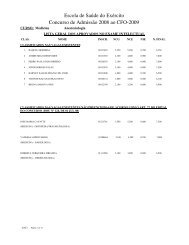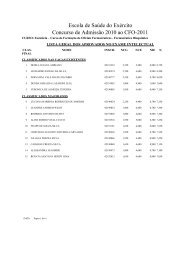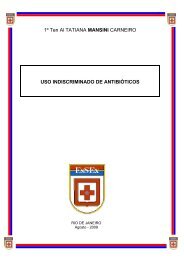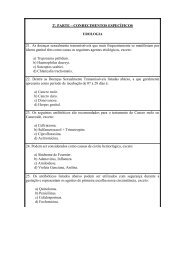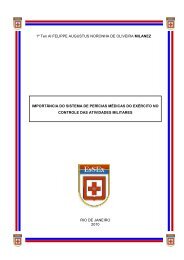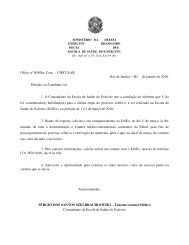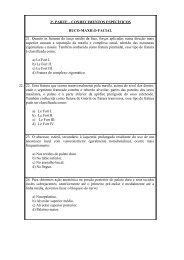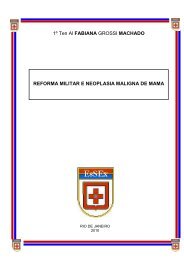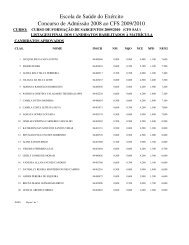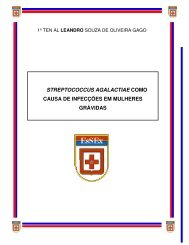RESUMOO Hospital Central <strong>do</strong> Exército, historicamente o mesmo edifica<strong>do</strong> em fins <strong>de</strong> 1768,no alto <strong>do</strong> Morro <strong>do</strong> Castelo, no ex-Colégio <strong>do</strong>s Jesuítas, representa, para a históriada Medicina Brasileira, um acervo <strong>do</strong>s mais significativos. Acompanhan<strong>do</strong> oprogresso da ciência médica e <strong>de</strong>le participan<strong>do</strong> em to<strong>do</strong>s os momentos, <strong>de</strong>monstraa capacida<strong>de</strong> da Medicina Militar que, na paz e na guerra, comprovou com eficiênciae senso humanitário. Atuações memoráveis <strong>de</strong> ilustres profissionais e fatossignificativos compõem o panorama histórico da instituição.Sua história tem início em 1759, quan<strong>do</strong> o então Colégio <strong>do</strong>s Jesuítas foi prepara<strong>do</strong>para receber o Vice-Rei Dom Antônio Rolim <strong>de</strong> Moura Tavares, o Con<strong>de</strong> <strong>de</strong>Azambuja. Em 1763 então o Vice-Rei transformou o quartel das Náus, situa<strong>do</strong> naRua <strong>do</strong>s Quartéis da Armada, no morro <strong>de</strong> São Bento, em enfermaria para abrigaros militares <strong>do</strong>entes que voltavam da batalha. Em 17 <strong>de</strong> novembro <strong>de</strong> 1766 <strong>de</strong>u-se aposse <strong>do</strong> Vice-Rei e em 09 <strong>de</strong> março <strong>de</strong> 1768 D. Antonio Rolim noticiou que iriamandar reformar o antigo Colégio <strong>do</strong>s Jesuítas para abrigar um hospital para osmilitares, visto que o Quartel das Náus já não comportava os <strong>do</strong>entes <strong>de</strong> maneiraa<strong>de</strong>quada. Com a aprovação <strong>do</strong> ministro, foram efetuadas as reparações no excolégioe, em 22 <strong>de</strong> janeiro <strong>de</strong> 1769 ocorre a instalação <strong>do</strong> novo hospital, o HospitalReal e Ultramar, primeiro nome da<strong>do</strong> ao Hospital Central <strong>do</strong> Exército. Em 1808, poror<strong>de</strong>m <strong>do</strong> Príncipe D. João, o hospital foi abrigo <strong>do</strong> ensino médico no Rio <strong>de</strong> Janeiro,com a criação da <strong>Escola</strong> Anatômica, Cirúrgica e Médica, sob a direção <strong>do</strong>Frei Custódio <strong>de</strong> Campos e Oliveira. Nas suas salas foram realizadas aulas,reuniões, atos cirúrgicos, conferências, solenida<strong>de</strong>s cívicas e cultos religiosos. Coma Proclamação da República,em 15 <strong>de</strong> Novembro <strong>de</strong> 1889, o serviço <strong>de</strong> saú<strong>de</strong>apresentou gran<strong>de</strong>s transformações, com a criação <strong>de</strong> novas unida<strong>de</strong>s <strong>de</strong> apoio e oexemplo disso foi o lançamento da pedra fundamental em 7 <strong>de</strong> Abril <strong>de</strong> 1890,através <strong>do</strong> chefe <strong>do</strong> governo provisório, Marechal Manoel Deo<strong>do</strong>ro da Fonseca, nacapital fe<strong>de</strong>ral, pelo <strong>de</strong>creto n°307, on<strong>de</strong> iniciava a construção <strong>do</strong> novo Hospital emBenfica, um hospital <strong>de</strong> primeira classe, sob a <strong>de</strong>nominação <strong>de</strong> Hospital Central <strong>do</strong>Exército. Hoje em dia, o Hospital Central <strong>do</strong> Exército continua a exercer o seurelevante papel no meio militar. Relembran<strong>do</strong> fatos e nomes históricos este trabalho<strong>de</strong>monstra aqui a importância da história da instituição, orgulho da Medicina Militar,berço <strong>do</strong> trabalho técnico, <strong>do</strong> ensino e <strong>de</strong> atitu<strong>de</strong>s <strong>de</strong> pioneirismo médico.Palavras-chave: Hospital Central <strong>do</strong> Exército, Serviço <strong>de</strong> Saú<strong>de</strong>, história
ABSTRACTThe Central Army Hospital, historically the same built in late 1768, on top of Morro <strong>do</strong>Catelo hill, the former Jesuit College, represents the history of Brazilian Medicine, acollection of the most significant. Accompanying the progress of medical science andhis part in all times, <strong>de</strong>monstrates the capacity of Military Medicine that, in peace andwar, with proven efficiency and humanitarianism. Memorable performances ofdistinguished professionals and significant facts make up the historical background ofthe institution. His story begins in 1759 when the then Jesuit College was prepared toreceive the Viceroy Dom Antonio Rolim <strong>de</strong> Moura Tavares, the Con<strong>de</strong> <strong>de</strong> Azambuja.In 1763 the then Viceroy became the headquarters of Naus, the Street of Quartéis daArmada on the hill of São Bento, in the military ward to accommodate patients whoreturned from battle. On November 17, 1766 gave up possession of the Viceroy andMarch 9, 1768 D. Antonio Rolim reported that would have restored the former Jesuitcollege to house a hospital for the military, since the headquarters of the Naus didnot inclu<strong>de</strong> patients already a<strong>de</strong>quately. With the approval of the minister, the repairswere ma<strong>de</strong> in former college and on January 22, 1769 is the installation of the newhospital, the Hospital Real e Ultramar, first name given to the Central Army Hospital.In 1808, by or<strong>de</strong>r of Prince D. João, the hospital was un<strong>de</strong>r medical teaching in Rio<strong>de</strong> Janeiro, with the creation of the School of Anatomy, Surgery and Medicine, un<strong>de</strong>rthe direction of Frei Custódio <strong>de</strong> Oliveira Campos. Its rooms were classrooms,meetings, surgical procedures, conferences, civic and religious cults. With theProclamation of the Republic on November 15, 1889, the health service introducedmajor changes, with the creation of new support units and the example was thelaunch of the foundation stone on April 7, 1890, through the head ofgovernment Interim Marchal Manuel Deo<strong>do</strong>ro da Fonseca, in the fe<strong>de</strong>ral capital, byDecree No. 307, which began the construction of the new hospital in Benfica, a firstclass hospital, un<strong>de</strong>r the name Central Army Hospital. Today, the Central ArmyHospital continues to exercise its important role in the military. Recalling facts andhistorical names that work here <strong>de</strong>monstrates the importance of the institution'shistory, pri<strong>de</strong> of Military Medicine, birthplace of the technical work, teaching andattitu<strong>de</strong>s of medical pioneers.Keywords: Central Army Hospital, health service, history



